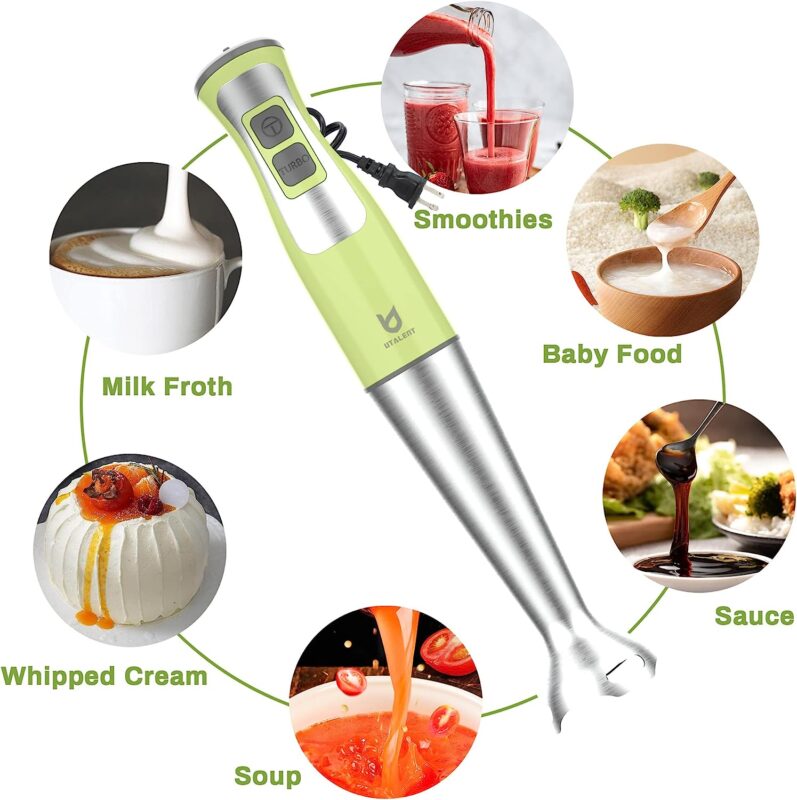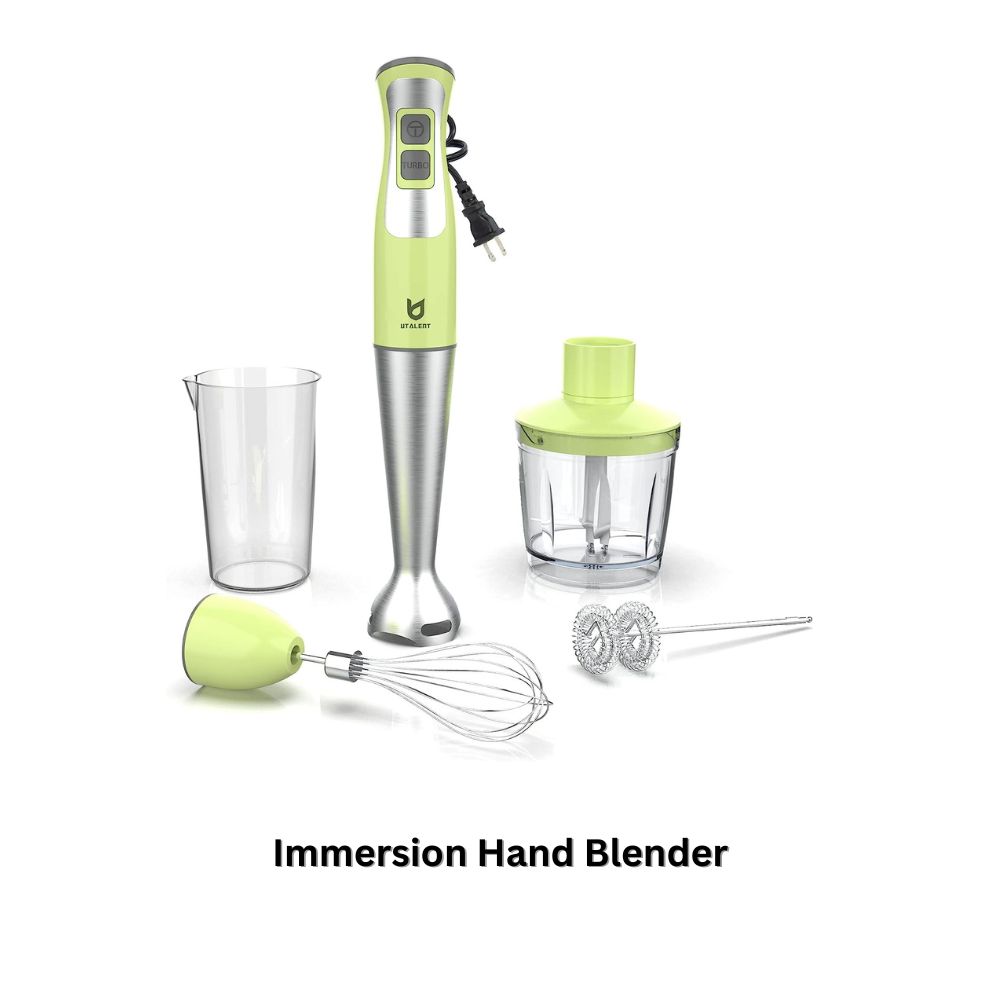Table of Contents
Introduction
In today’s fast-paced world, having a versatile kitchen tool that can effortlessly handle various culinary tasks is a game-changer. That’s where immersion hand blenders come in. With their compact design and powerful performance, these handy gadgets have revolutionized the way we prepare food. In this comprehensive guide, we will delve into the world of immersion hand blenders and explore their uses, benefits, and how to choose the best one for your needs.
1. What is an Immersion Hand Blender?
An immersion hand blender, also known as a stick blender or hand blender, is a portable kitchen appliance that allows you to blend, puree, and mix ingredients directly in the cooking vessel. Unlike traditional countertop blenders, immersion blenders are handheld and can be immersed directly into pots, bowls, or containers, eliminating the need for transferring ingredients.
How Does an Immersion Hand Blender Work?

An immersion hand blender consists of a motorized handle with a control panel and a detachable blending head. The blending head contains a set of rotating blades that create a vortex, pulling the ingredients towards them for efficient blending. By adjusting the speed settings, you can control the blending process to achieve the desired consistency.
Advantages of Using an Immersion Hand Blender
- Versatility: Immersion hand blenders are incredibly versatile and can perform a wide range of tasks, from blending soups to whisking eggs.
- Convenience: The compact size and lightweight design of immersion blenders make them easy to handle and store.
- Efficiency: With their powerful motors and sharp blades, immersion blenders can quickly blend ingredients to a smooth texture.
- Easy Cleanup: Immersion blenders are much easier to clean compared to traditional blenders, as they can be directly rinsed or washed with minimal disassembly.
- Time-Saving: By eliminating the need for transferring ingredients between containers, immersion blenders save time and reduce the number of dishes to clean.
2. Key Features to Consider When Choosing an Immersion Hand Blender
When shopping for an immersion hand blender, it’s essential to consider several key features to ensure you select the best one for your needs. Let’s explore these features in detail:
Power and Speed Settings
The power of an immersion hand blender is measured in watts, and a higher wattage typically indicates a more powerful motor. Look for a blender with at least 200 watts for satisfactory performance. Additionally, check for multiple speed settings to have better control over the blending process.
Blade Design and Material
The blade design plays a crucial role in the blender’s performance. Opt for a blender with sharp and durable stainless steel blades that can handle tough ingredients without dulling or rusting. Some blenders come with interchangeable blade attachments for specific tasks, such as chopping or whisking.
Ergonomics and Handle Grip
Since you’ll be holding the immersion blender during blending, it’s important to choose one with an ergonomic design and a comfortable handle grip. Look for a blender with a non-slip handle that provides a secure and cushioned grip, preventing hand fatigue during extended use.
Attachments and Accessories
Consider the attachments and accessories that come with the immersion blender. Many blenders offer additional attachments such as a whisk or a chopper, which expands their functionality. Some blenders even come with a storage case to keep all the attachments organized.
3. Immersion Hand Blender Uses and Applications
One of the biggest advantages of immersion hand blenders is their versatility. Let’s explore some of the common uses and applications of these handy kitchen tools:
Making Smoothies and Milkshakes

With an immersion hand blender, you can effortlessly whip up delicious smoothies and milkshakes in no time. Simply place your favorite fruits, yogurt, and ice in a tall container, immerse the blender, and blend until smooth. The compact size of the immersion blender makes it perfect for single servings.
Creating Velvety Soups and Sauces
Immersion blenders are a game-changer when it comes to making creamy soups and sauces. Instead of transferring hot liquids to a countertop blender, you can blend them directly in the pot. Whether you’re making a classic tomato soup or a velvety béchamel sauce, the immersion blender ensures a smooth and consistent texture.
Whipping Cream and Beating Eggs
When it comes to whipping cream or beating eggs, an immersion hand blender can save you time and effort. Attach the whisk attachment to the blender, place the ingredients in a deep bowl, and blend until you achieve the desired consistency. Within minutes, you’ll have perfectly whipped cream or fluffy beaten eggs.
Pureeing Baby Food
Preparing homemade baby food becomes a breeze with an immersion hand blender. Whether you’re pureeing fruits, vegetables, or a combination of both, the immersion blender ensures a smooth and easily digestible texture for your little one. Its compact size also makes it convenient for on-the-go meals.
Grinding Nuts and Seeds
An immersion hand blender with a grinder attachment can easily grind nuts, seeds, and spices. Whether you’re making your own nut butter or creating a custom spice blend, the blender’s powerful motor and sharp blades make the grinding process quick and effortless.
Frothing Milk for Lattes and Cappuccinos

If you’re a coffee enthusiast, an immersion hand blender with a milk frother attachment is a must-have. It allows you to froth milk for lattes, cappuccinos, and other specialty coffee drinks right at home. Simply immerse the frother in a cup of warm milk and blend until you achieve a creamy froth.
4. How to Properly Use an Immersion Hand Blender

To get the best results and ensure safety while using an immersion hand blender, follow these step-by-step instructions:
Preparing Your Ingredients
Before you start blending, ensure that your ingredients are prepared and ready to go. This may include chopping fruits or vegetables into smaller pieces, measuring out liquids, or preheating liquids if necessary.
Assembling the Blender
Assemble the immersion hand blender by attaching the blending head securely to the motorized handle. Ensure that it clicks into place and is firmly attached before proceeding.
Using the Blender Safely
When using the immersion blender, always keep safety in mind. Avoid immersing the blender beyond the maximum fill line indicated on the blending head. This prevents spills and ensures that the ingredients are properly blended.
Cleaning and Maintenance Tips
After using the immersion hand blender, detach the blending head and rinse it under warm water to remove any residue. If the blending head is dishwasher-safe, you can also place it in the dishwasher for easy cleaning. Wipe the motorized handle with a damp cloth and store the blender and its attachments in a safe and dry place.
6. Tips and Tricks for Getting the Most out of Your Immersion Hand Blender
To maximize the potential of your immersion hand blender, here are some tips and tricks to consider:
Experimenting with Different Ingredients
Don’t be afraid to experiment with a variety of ingredients. From fruits and vegetables to nuts and spices, the immersion blender can handle them all. Get creative and try new combinations to discover unique flavors and textures.
Blending Hot Liquids Safely
When blending hot liquids, it’s crucial to take precautions to avoid splatters and burns. Use a tall container to prevent liquid from splashing out, and ensure the blending head is fully immersed before turning on the blender. For added safety, consider using a blender with a heat-resistant blending head.
Creating Custom Blends and Mixes
With an immersion hand blender, you can easily create custom blends and mixes. Blend together different fruits for a refreshing fruit puree or mix herbs and spices for a homemade seasoning blend. The possibilities are endless, and you can tailor the flavors to suit your preferences.
Storing and Preserving Blended Foods
If you have leftover blended food, it’s important to store and preserve it properly. Use airtight containers or freezer-safe bags to store soups, sauces, or purees. Label them with the date, and they can be stored in the refrigerator or freezer for future use.
Troubleshooting Common Issues
If you encounter any issues while using your immersion hand blender, here are some common troubleshooting tips:
- If the blender is struggling to blend, try cutting the ingredients into smaller pieces or adding a little liquid to facilitate blending.
- If the blender is overheating, give it a break and allow it to cool down before continuing.
- If the blender is not turning on, ensure that it is securely connected to the motorized handle and that the power source is working.
7. Immersion Hand Blender vs. Traditional Blenders: Which One is Right for You?
While immersion hand blenders offer convenience and versatility, traditional countertop blenders also have their merits. Let’s compare the two to help you make an informed decision:
Size and Portability
Immersion hand blenders are compact and portable, making them ideal for small kitchens or for those who frequently travel. Traditional blenders, on the other hand, take up more counter space and are less portable.
Versatility and Functionality
When it comes to versatility, immersion hand blenders take the lead. They can handle various tasks, from blending to whisking and chopping. Traditional blenders are primarily designed for blending and may not offer the same level of versatility.
Cleaning and Maintenance
In terms of cleaning and maintenance, immersion hand blenders are easier to clean. They can be directly rinsed or washed with minimal disassembly. Traditional blenders often have more parts to clean and require disassembly for thorough cleaning.
Price Range
In general, immersion hand blenders are more affordable compared to traditional blenders. They offer excellent value for money, especially considering their versatility and convenience.
8. Frequently Asked Questions (FAQs)
Can I use an immersion hand blender in non-stick cookware?
Yes, immersion hand blenders are safe to use in non-stick cookware. However, it’s essential to avoid scraping the blender against the non-stick surface to prevent any damage.
Is it safe to use an immersion hand blender with hot liquids?
Yes, immersion hand blenders are designed to handle hot liquids. However, it’s crucial to take safety precautions, such as using a tall container to prevent splatters and ensuring the blending head is fully immersed before turning on the blender.
Can I blend frozen fruits with an immersion hand blender?
Yes, immersion hand blenders can handle blending frozen fruits. However, it’s important to ensure that the blender has enough power and sharp blades to handle the frozen ingredients.
How long can I run an immersion hand blender continuously?
The continuous run time of an immersion hand blender depends on the specific model and its motor. Refer to the manufacturer’s guidelines for the recommended maximum run time to avoid overheating the motor.
Can I chop vegetables with an immersion hand blender?
While immersion hand blenders are primarily designed for blending and pureeing, some models come with a chopper attachment that allows you to chop vegetables. However, the chopping results may not be as precise or consistent as using a dedicated food processor.
9. Conclusion
Embrace the versatility of immersion hand blenders and unlock a world of culinary possibilities. Whether you’re whipping up smoothies, creating velvety soups, or pureeing baby food, these compact and powerful kitchen tools will make your cooking experience easier and more enjoyable. By considering the key features, following proper usage guidelines, and exploring various tips and tricks, you can make the most out of your immersion hand blender. Choose the perfect blender that suits your needs, and elevate your culinary skills to new heights. With an immersion hand blender by your side, the possibilities are endless.

